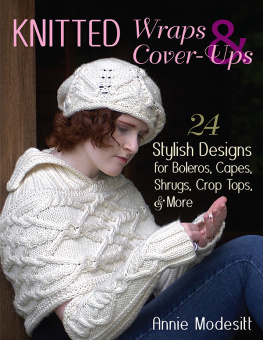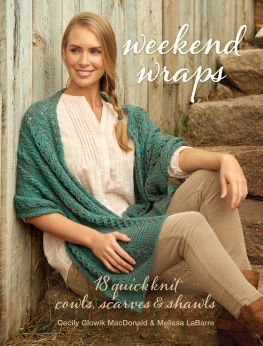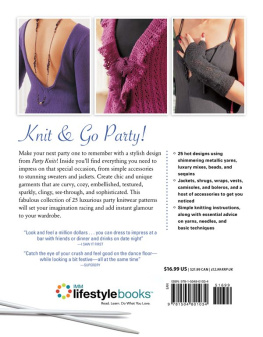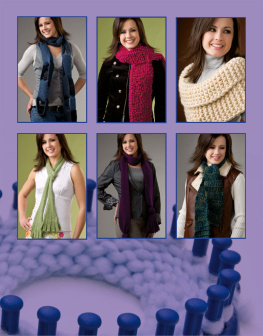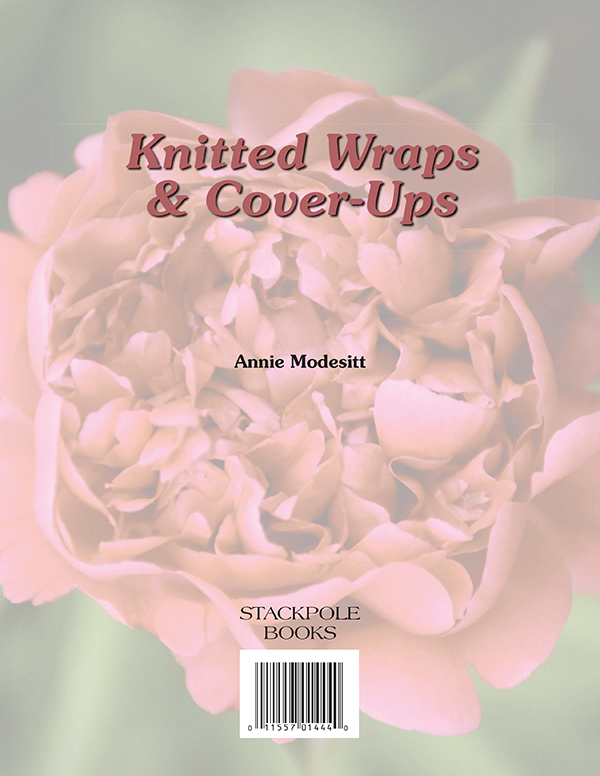
W e love small things. We love cute, compact pieces cunningly crafted to cover the chilly contours of a shoulder, neck, or arm.
As knitters, we have a bit of a quandary. We love knitting useful garments to keep us (and our loved ones) warm and comfortable, but often we dont like to commit to a very large project. Socks are fun, scarves and hats are wonderful, but sometimes a tiny bit of a sweater is just what the knitting doctor ordered.
The humble size of a bolero can trick the mind into believing it is utterly ingenuous. But sometimes small things are uniquely sophisticated in their simplicity.
With a few exceptions, the patterns in this book are moderate to smaller sized pieces designed to warm a chilly neck at the office, snug around bare shoulders in a restaurant, or offer a bit of coziness when out for an evening stroll.
I think of these designs as partial sweaters. Boleros, armerys, shrugs, and shawls are all names for pieces that are fun, relatively quick to knit up, and serve a specific function.
Ive attempted to design items which are useful, can be easily sized larger or smaller, andmost of allare fun to knit! Id wear any of them (and often do) and I hope my readers find them as enjoyable to knit and wear as I do.
WELCOME TO ALL KNITTERS
As a designer and pattern writer, I strive to create patterns that are democratically writtenpatterns that anyone can use, which dont exclude any style of knitting (there are more styles than you may know: Eastern, Combination, Left-Handed, and Portuguese, to name a few). To this end, certain knitting terms used in this book may be new to some knitters. As a rule, I try to use knitting terms that describe the final result of a technique, not how to work the technique, since the how varies across different styles of knitting but the results desired are the same. The terms I use that may be new to you are not difficult to understand and should equate easily to what you already know. For more information on different knitting styles and terminology, see How To Use This Book on .
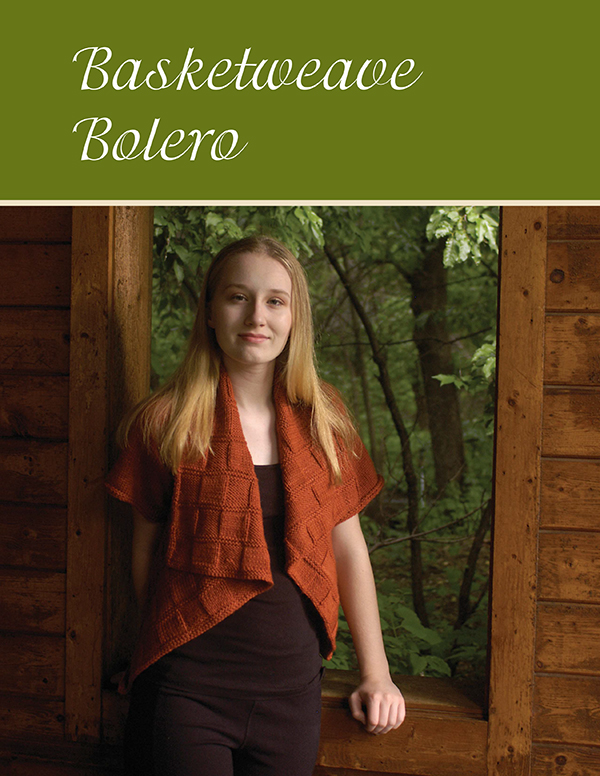
T o create the basketweave pattern, square areas of stockinette stitch are juxtaposed with reverse stockinette stitch, divided by a few rows of garter stitch. This creates a drapey, simple fabric which ows around the body in an easy, flattering way.
Sizes
To fit bust 28 (36, 44, 58)"/71 (92, 112, 148) cm
Finished Measurements
Width: 24 (28, 32, 36)"/61 (71, 82, 92) cm
Length: 35 (43, 51, 59)"/89 (110, 130, 151) cm
Skill Level
Easy
Yarn
Eden Cottage Langdale Superwash Aran, medium weight #4 yarn (100% merino; 180 yd./166 m per 3.5 oz./100 g skein)
5 (7, 9, 13) skeins Copper Beech
Needles and Other Materials
US 8 (5 mm) needles
Gauge
16 sts x 24 rows in St st = 4"/10 cm square
Adjust needle size if necessary to obtain gauge.
Stitch Guide
Dkss Edge (double knit slipped st edge, worked over 3 sts)
This edging is created by slipping and knitting stitches, keeping in mind that whenever stitches are slipped at either 3-st edge, the yarn is held toward the knitter, regardless of whether the right or wrong side is facing the knitter. On the RS rows, at either end, the 3 edge sts are worked knit, slip, knit. On the WS rows, at either end, the 3 edge sts are worked slip, knit, slip.
RS Row: {K1, wyrs sl 1, k1}, work to last 3 sts, {k1, wyrs sl 1, k1}.
WS Row: {Wyws sl 1, k1, wyws sl 1}, work to last 3 sts, {wyws sl 1, k1, wyws sl 1}.
Wyrs sl 1 (with yarn right side, slip 1)
Move yarn to RS of work. Insert RH needle purlwise into st and slip off of LH needle.
Wyws sl 1 (with yarn wrong side, slip 1)
Move yarn to WS of work. Insert RH needle purlwise into st and slip off of LH needle.
Jacket
CO 106 (122, 138, 154) sts.
Knit 4 rows.
BEGIN BASKETWEAVE PATTERN
Follow Chart or written instructions as foll:
Row 1 (RS): {K1, wyrs sl 1, k1}, p2, [k16] rep 6 (7, 8, 9) times to last 5 sts, p2, {k1, wyrs sl 1, k1}.
Row 2 (WS): {Wyws sl 1, k1, wyws sl 1}, k2, [k16] rep to last 5 sts, k2, {wyws sl 1, k1, wyws sl 1}.
Row 3: {Dkss edge}, k1, wyrs sl 1, k1, p2, [k8, p8] rep 6 (7, 8, 9) times to last 5 sts, p2, {dkss edge}.
Row 4: {Dkss edge}, k2, [p8, k8] rep 6 (7, 8, 9) times to last 5 sts, k2, {dkss edge}.
Rows 512: Rep last 2 rows 8 times more (10 rows total).
Rows 1316: Rep Rows 12 twice.
Row 17: {Dkss edge}, p2, [p8, k8] rep 6 (7, 8, 9) times to last 5 sts, p2, {dkss edge}.
Row 18: {Dkss edge}, k2, [k8, p8] rep 6 (7, 8, 9) times to last 5 sts, k2, {dkss edge}.
Rows 1926: Rep last 2 rows 8 times more (10 rows total).
Rows 2728: Rep Rows 12.
Rep Rows 128 until a total of 6 (7, 8, 11) 14-row squares have been worked (ending either at Row 14 or 28).
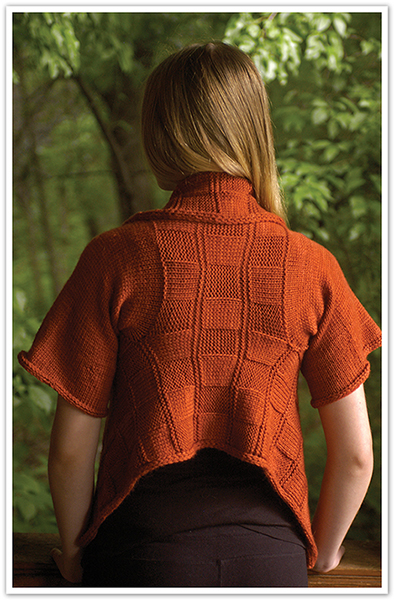

ARMHOLE PLACEMENT
Cont in patt as est, create the armhole placement by working 37 (45, 53, 53) sts in patt as est. With a piece of waste yarn, k32 (32, 32, 48) sts. Break waste yarn and set aside. Slip these waste yarn sts back onto the left-hand needle, and cont with body yarn, work in basketweave patt as est across the waste yarn sts and to the end of the row.
Cont in patt as est, complete 42 (56, 70, 84) rows (these rows will be the Back of the garment), then work another armhole placement row as previously worked.
Cont in basketweave patt as est until a total of 6 (7, 8, 11) 14-row squares have been worked from the second waste yarn armhole placement (ending either at row 14 or 28). Bind off all sts loosely.
Sleeve (Make 2)
Return to one waste yarn armhole placement and carefully remove the waste yarn while slipping the 32 (32, 32, 48) sts from one edge of the armhole and 31 (31, 31, 47) from the other edge of the armhole onto a circular needle63 (63, 63, 95) sts total. Join yarn to work and place marker to note start of round. Work in St st (knit every round) until sleeve meas 10 (10, 11, 11)"/26 (27, 28, 29) cm, or desired length. Bind off all sts using an I-cord bind-off as follows:
To start, cast on 3 sts at start of row/round.
1. K2, k2tog-L.
2. Slip 3 sts from RH needle back onto LH needle.
3. Pull yarn taut across back of work.
4. Repeat steps 13 across work until 3 sts rem.
5. End k3tog-L, tie off last stitch.
Finishing
Use yarn tails from sleeves to tidy up armhole and cuff edges as you weave in the ends. Steam block piece.

